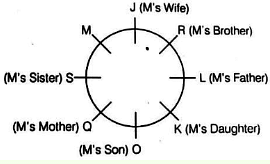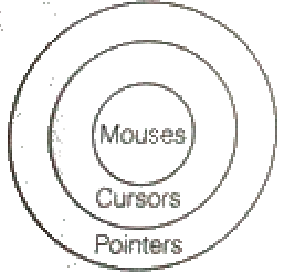Practice Mock Test for SNAP - 5 - CAT MCQ
30 Questions MCQ Test - Practice Mock Test for SNAP - 5
Read sentence to find out whether there is any grammatical error in it. The sentences are In three separate parts and each one is labelled (a), (b), (c) and (d). In that case, letter (d) will signify a ‘No error’ response.
Find out the error part of the following sentences.
Read sentence to find out whether there is any grammatical error in it. The sentences are In three separate parts and each one is labelled (a), (b), (c) and (d). In that case, letter (d) will signify a ‘No error’ response.
Read the sentence (given as options) to find out whether there is any grammatical error in it. The sentences are In three separate parts and each one is labelled (a), (b), (c) and (d). In that case, letter (d) will signify a ‘No error’ response.
Find out the error part of the following sentences.
Read sentence to find out whether there is any grammatical error in it. The sentences are In three separate parts and each one is labelled (a), (b), (c) and (d). In that case, letter (d) will signify a ‘No error’ response.
Spot the error part of the following sentences.
Such books which you read are not worth reading.
Read sentence to find out whether there is any grammatical error in it. The sentences are In three separate parts and each one is labelled (a), (b), (c) and (d). In that case, letter (d) will signify a ‘No error’ response.
Find out the error part of the following sentences.
Read sentence to find out whether there is any grammatical error in it. The sentences are In three separate parts and each one is labelled (a), (b), (c) and (d). In that case, letter (d) will signify a ‘No error’ response.
Three of the following four are alike in a certain way and so form a group. Which is the one that does not belong to that group?
Question: How many such pairs of letters are there in the word SECURITY, each of which has as many letters between them in the word (in both forward and backward directions) as in the English alphabetical series?
Directions: Study the arrangement carefully and answer the questions given below.
4 2 6 1 3 8 9 5 8 1 6 5 1 5 8 5 3 9 4 9 2 3 2 1 5 7 2 6 2 4 2 7 4
Q. Which of the following is seventh to the right of the nineteenth digit from the right end of the above arrangement?
Directions: Six people – C, D, E, F, G and H are standing in a straight line facing North not necessarily in the same order. D is standing second to the right of F. C is standing fourth to the left of H and H is not standing on the extreme end of the line. E is standing second to the right of D.
Q. Who is standing second to the right of C?
Directions: Six people – C, D, E, F, G and H are standing in a straight line facing North not necessarily in the same order. D is standing second to the right of F. C is standing fourth to the left of H and H is not standing on the extreme end of the line. E is standing second to the right of D.
Q. All the people are asked to stand in an alphabetical order from left to right, the positions at how many will remain unchanged?
Directions: In the given information and answer the questions.
When a word and number arrangement machine is given an input line of words and numbers it arranged them following a particular rule. The following is an illustration of input and rearrangement. (All the numbers are two-digit numbers)
Input left 46burn 82 95 part 72 vibe bold 49 mint 59
Step I95 left 46 burn 82 part 72 vibe 49 mint 59 bold
Step II 82 95 left 46 part 72 vibe 49 mint 59 bold burn
Step III 72 82 95 46 part vibe 49 mint 59 bold burn left
Step IV 59 72 82 95 46 part vibe 49 bold burn left mint
Step V49 59 72 82 95 46 vibe bold burn left mint part
Step VI 46 49 59 72 82 95 bold burn left mint part vibe
Step VI is the last step of the above arrangement as the intended output of arrangement is obtained. As per the rules followed in the given steps, find the appropriate steps for the given input.
Input 29 cone 42 pale fear 39 67 fame 32 weld 77 turn
Q. How many elements are there between ‘77’ and ‘weld’ in the last step?
Directions: In the given information and answer the questions.
When a word and number arrangement machine is given an input line of words and numbers it arranged them following a particular rule. The following is an illustration of input and rearrangement. (All the numbers are two-digit numbers)
Input left 46burn 82 95 part 72 vibe bold 49 mint 59
Step I95 left 46 burn 82 part 72 vibe 49 mint 59 bold
Step II 82 95 left 46 part 72 vibe 49 mint 59 bold burn
Step III 72 82 95 46 part vibe 49 mint 59 bold burn left
Step IV 59 72 82 95 46 part vibe 49 bold burn left mint
Step V49 59 72 82 95 46 vibe bold burn left mint part
Step VI 46 49 59 72 82 95 bold burn left mint part vibe
Step VI is the last step of the above arrangement as the intended output of arrangement is obtained. As per the rules followed in the given steps, find the appropriate steps for the given input.
Input 29 cone 42 pale fear 39 67 fame 32 weld 77 turn
Q. Which of the following represents the first two and the last two elements in the third last step?
Directions: The question consists of a question and two statements numbered I and II given below it. You have to decide whether the data given in the statements are sufficient to answer the questions. Read both the statements and choose the most appropriate option.
Q. How is the word ‘plant’ written in the given code language?
I. ‘Buy a new plant today’ is written as ‘4 $ % 7 2’ and ‘not the plant she said’ is written as ‘@ # 5 # 9’.
II. ‘Plant is always good’ is written as ‘> 6 3 $’ and ‘is good buy always’ is written as ‘3 > 2 6’.
Directions: Read the given information carefully and answer the question.
J, K, L, M, O, Q, R and S are sitting around a circular table facing the centre with equal distances between each other (but not necessarily in the same order). Each one of them is also related to M in some way or the other. Only two people sit between Q and L. M sits second to the left of Q. Only three people sit between L and M’s sister. M’s son sits second to the right of M’s sister. Only one person sits between M’s sister and S. J sits to the immediate right of R. R is neither the son nor the mother of M. S is an immediate neighbour of M’s mother. Only three people sit between M’s mother M’s brother. M’s daughter sits second to the left of M’s brother. M’s father is not an immediate neighbour of M. M’s wife sits third to the right of K.
Q. How many people sit between K and L, when counted from left of L?
Directions: The questions below are two statements followed by two conclusions numbered I and II. You have to take the three given statements to be true even if they seem to be at variance from commonly known facts and then decide which of the given conclusions logically follows from the three given statements disregarding commonly known facts. Then decide which of the answer (a), (b), (c), (d) and (e) is the correct answer.
Statement: All mouses are cursors. All cursors are pointers.
Conclusions
I. All mouses are pointers.
II. All pointers are cursors.
Directions: In each question below a statement is given followed by two courses of action numbered I and II. A course of action is a practicable and feasible step or administrative decision to be taken for follow-up, improvement, or further action in regard to the problem, Policy etc. On the basis of the information given in the statement, you have to assume everything in the statement to be true, and decide which of suggested courses of action logically follow(s) for pursuing
Statement: The sales of ballpoint manufactured by company Lixus have gone down considerably ever since the same company introduced a gel-ink pen in the market.
Courses of Action
I. Ball-point pens should manufactured by Lixus and more.
II. Lixus should immediately withdraw all gel-ink pens from the market so as to force people to buy ball-point pens.
Directions: In each question below a statement is given followed by two assumptions numbered I and II. An assumption is something supposed or taken for granted. You have to consider the statement and the following assumptions and decide which of the assumptions is implicit in the statement.
Statement: Use our medicine to fight the problem of obesity.
Assumptions
I. Other slimming medicines available in the market do not reduce weight.
II. Obesity cannot be controlled without medicines.
Direction: In each question below a statement is given followed by two assumptions numbered I and II. An assumption is something supposed or taken for granted. You have to consider the statement and the following assumptions and decide which of the assumptions is implicit in the statement.
Statement: For any kind of problem with your mobile phone, contact our help desk immediately.
Assumptions
I. Help desk has a solution to all kinds of problems related to mobile phones or will guide accordingly.
II. Unless the problem is reported immediately it cannot be solved.
Direction: In this question are given four statements followed by five conclusions one of which definitely does not logically follow (or is not a possibility of occurrence) from the given statements. That conclusion is your answer.
Note: You have to take the four given statements to be true even it they seem to be at variance with commonly known facts and then decide which of the given conclusions logically does not follow from the given statements disregarding commonly known facts.
Statements: No toy is a doll.
Conclusions
All guns are toys.
All houses are dolls.
All dolls are baskets.
Direction: The questions below are two statements followed by two conclusions numbered I and II. You have to take the three given statements to be true even if they seem to be at variance from commonly known facts and then decide which of the given conclusions logically follows from the three given statements disregarding commonly known facts. Then decide which of the answer (a), (b), (c), (d) and (e) is the correct answer.
Statements: All pins are staplers. Some staplers are rulers.
Conclusions
I. Some pins are rulers.
II. All rulers are pins.
























